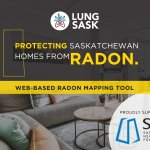Lung Sask in Partnership with the Take Action on Radon Coalition Commends the Government of Saskatchewan for Including Radon Mitigation Costs under the New Home Renovation Tax Credit
For Immediate Release
SASKATOON, January 14, 2021 -- Radon is the second leading cause of lung cancer. It is a gas formed by the breakdown of uranium, a natural radioactive material found in all soil and rock, and Saskatchewan is a hot spot. As radon breaks down, it forms radioactive particles that can get lodged into your lung tissue as you breathe creating the risk of lung cancer. The only way to know how much radon is in your home is to test with a long-term radon test kit. If radon levels are high, a certified radon reduction professional can mitigate your home to bring radon levels down which will reduce the risk of lung cancer.
The Provincial Government’s Home Renovation Tax Credit allows home owners to claim a 10.5 per cent tax credit on up to $20,000 of eligible home renovation expenses. The eligible expenses include the cost of labour, professional services, and the building materials required for radon reduction measures. “In a year when we are spending so much time at home, our government is proud to be able to assist Saskatchewan residents in keeping their homes safe,” said Paul Merriman, Minister of Health. “Radon-caused lung cancer can be prevented through simple basement renovations, which will now be much more affordable thanks to our government’s Home Renovation Tax Credit.”
“On behalf of Lung Sask and the Take Action on Radon Coalition we commend Minister Merriman and the Saskatchewan Government for including radon reduction costs in the Home Renovation Tax Credit Program. This initiative will support home owners who take action to invest in the cost of radon mitigation, it will support Saskatchewan small business, and more importantly it will help to protect the lung health of Saskatchewan residents,” says Jennifer May, Vice President of Health Promotion. “We recommend all homeowners test their home to know their radon number. Radon tests can be purchased at HomeRadonTest.ca”.
Pam Warkentin, Executive Director of the Canadian Association of Radon Scientists and Technologists (CARST) says, “Reduce your radon and reduce your risk. Homeowners can find certified radon reduction (mitigation) professionals to help them reduce their radon level through the Canadian National Radon Proficiency Program (C-NRPP). Health Canada recommends using a certified contractor as they are properly trained.”
Lung Sask has ambassadors who are sharing their powerful stories about how radon has impacted their lives and their health through the My Radon Story campaign. Among the ambassadors is Kerri Tucker, a Saskatchewan mother who survived lung cancer attributed to radon exposure. “Lung cancer from radon happened to me and can happen to you too, but it’s completely preventable,” Tucker stresses. “As a radon induced lung cancer survivor, I encourage all homeowners to test for and then reduce their levels of radon, if needed. The financial and emotional toll of cancer on families is incredible and anything we can do to reduce that risk is extremely important. The more homes that get tested and mitigated, the fewer future lung cancer diagnoses!”
Joining Tucker in the My Radon Story campaign are other lung cancer survivors, as well as lung specialists, public health experts and scientists. Their journeys are all different, but they have united together with the same message, test your home for radon and if radon levels are high, work with a certified radon reduction professional to lower your radon levels to protect you and your family. Visit MyRadonStory to read their powerful stories.
-30-
Resources:
Radon kits: https://www.homeradontest.ca
Certified Mitigation Experts: https://takeactiononradon.ca/test/find-a-radon-mitigation-professional/
My Radon Story Campaign: https://www.homeradontest.ca/story
Saskatchewan Home Renovation Tax Credit: https://www.saskatchewan.ca/residents/taxes-and-investments/tax-credits/home-renovation-tax-credit




